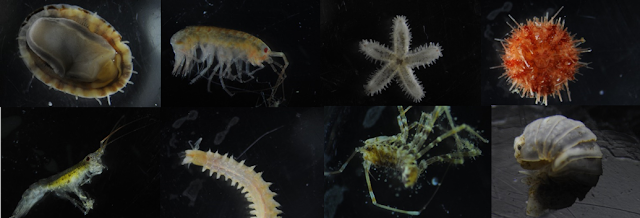The Invertebrate Backstory
As promised- at last a science based blog and I apologies for the delay! I can only say that coming back for a second winter in Rothera has made me feel even more disconnected from the 'real' world.
As touched on in a previous post, I am continuing to pursue a research goal centered around understanding the role of marine plants in Antarctic ecosystems. Globally marine plants play an incredibly important role in aquatic ecosystems such as supporting food webs and providing shelter for an array of organisms. When marine plants erode and senesce, some of their carbon is transferred through the ecosystem in the form of detritus. The rest of the plant material remains in situ where the carbon is remineralised (broken down) by invertebrate grazers and bacteria. Plant material can be exported from shallow, coastal habitats into deeper sediments (known as carbon sinks) where it is buried. This process if known as carbon sequestration.
Our dive team has been sampling accumulations of Antarctic macroalgae (seaweed) detritus across the year. By collecting the invertebrate community associated with these marine plants (the detritivores), we are able to pursue questions about the role of macroalgae resources in supporting invertebrate food webs.
An example of invertebrates associated with macroalgae samples
To understand how time affects the breakdown of seaweed material, I sample the experimental detrital accumulations at different time points across the year which allows me to track the succession of the invertebrate community.
A white sorting tray is useful to provide colour contrast when sorting through samples.
I first sort the species into taxonomic groupings (ie. molluscs, amphipods (small crustaceans), isopods (related to woodlouse), polychaetes (worms), pycnogonids (sea spiders)) and use a microscope to photograph and identify individuals to species level where possible.
Stable isotope analysis allows elements such as carbon, nitrogen and sulphur to trace the flow of nutrients through food webs. I freeze samples of the most dominant consumers for stable isotope analysis to determine which species are eating the resource and which species use it as shelter.
I hope you enjoy this gallery of some of the species I have encountered here in Antarctica!


















Hi Nadia. Our time has come at last! Tomorrow we set off on our journey that will lead, eventually to Antarctica. From Devon we drive to Manchester where we catch a flight to Schipol and then on to São Paulo, then Montevideo where we board the ship “Expedition” bound for the Falklands, South Georgia, South Shetlands and finally the Antarctic Peninsula where we should arrive about 7/8th November. I have another letter to you that I will bring with me. I have just read Terra Incognita and have been struck by her descriptions of the psychological effects of overwintering. Hope you are ok!
ReplyDeleteDear Nadia, a remarkable blogspot from a miraculous marine biologist! Such compulsive content combined with entrancing images of marine invertebrates! From film photography to microscoped photography, what a wonderful insight into the life of a scientist living 67° South. I have enjoyed you blogs and podcasts. I just wanted to say 'Hi' with warm hugs,
ReplyDeleteMr.Whiteleaf!
Thank you very much Mr.Whiteleaf. That is very kind indeed. You are quite the specimen yourself and an excellent Ornithologist that I greatly admire
DeleteIncredible news, well done;)
ReplyDelete